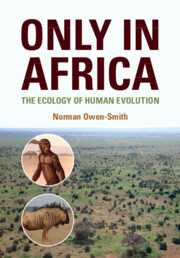Book contents
- Only in Africa
- Only in Africa
- Copyright page
- Dedication
- Contents
- Foreword
- Preface
- Abbreviations
- Part I The Physical Cradle: Land Forms, Geology, Climate, Hydrology and Soils
- Part II The Savanna Garden: Grassy Vegetation and Plant Dynamics
- Chapter 6 Forms of Savanna: From Woodland to Grassland
- Chapter 7 How Trees and Grasses Grow and Compete
- Chapter 8 Plant Demography and Dynamics: Fire Traps
- Chapter 9 Paleo-savannas: Expanding Grasslands
- Part II Synthesis: Savanna Structure and Dynamics
- Part III The Big Mammal Menagerie: Herbivores, Carnivores and Their Ecosystem Impacts
- Part IV Evolutionary Transitions: From Primate Ancestors to Modern Humans
- Appendix Scientific Names of Extant Animal and Plant Species Mentioned in the Book Chapters (Ecologically Conservative with Regard to Species Recognition)
- Index
- References
Chapter 8 - Plant Demography and Dynamics: Fire Traps
from Part II - The Savanna Garden: Grassy Vegetation and Plant Dynamics
Published online by Cambridge University Press: 09 September 2021
- Only in Africa
- Only in Africa
- Copyright page
- Dedication
- Contents
- Foreword
- Preface
- Abbreviations
- Part I The Physical Cradle: Land Forms, Geology, Climate, Hydrology and Soils
- Part II The Savanna Garden: Grassy Vegetation and Plant Dynamics
- Chapter 6 Forms of Savanna: From Woodland to Grassland
- Chapter 7 How Trees and Grasses Grow and Compete
- Chapter 8 Plant Demography and Dynamics: Fire Traps
- Chapter 9 Paleo-savannas: Expanding Grasslands
- Part II Synthesis: Savanna Structure and Dynamics
- Part III The Big Mammal Menagerie: Herbivores, Carnivores and Their Ecosystem Impacts
- Part IV Evolutionary Transitions: From Primate Ancestors to Modern Humans
- Appendix Scientific Names of Extant Animal and Plant Species Mentioned in the Book Chapters (Ecologically Conservative with Regard to Species Recognition)
- Index
- References
Summary
This chapter is concerned with numerical changes in tree and grass populations. Size structure distributions of savanna trees vary widely, suggesting episodic recruitment is widespread. Life-history transitions of savanna trees are erratic and contingent on prevailing conditions, especially fire return intervals. Savanna trees vary widely in potential longevity, from several decades to thousands of years. Tree populations may be expanding or contracting in response to climatic variation or contingent influences. Grasses increase numerically through proliferation of either tillers, tufts or runners. Grass populations may turn over between one year and the next following drought or heavy grazing. Refuge sites enable grass species to persist through prolonged droughts.
Keywords
- Type
- Chapter
- Information
- Only in AfricaThe Ecology of Human Evolution, pp. 118 - 127Publisher: Cambridge University PressPrint publication year: 2021

